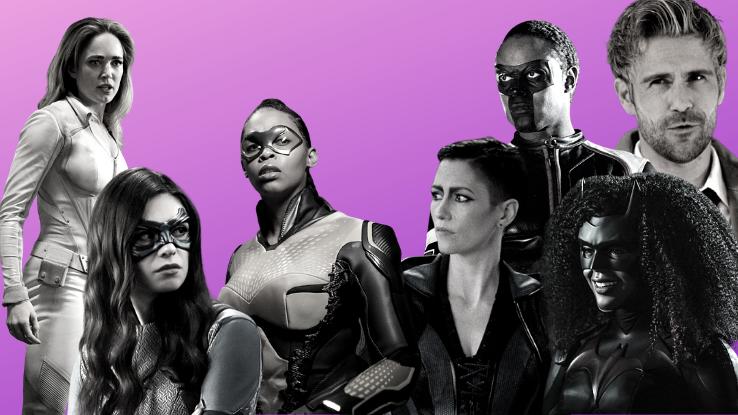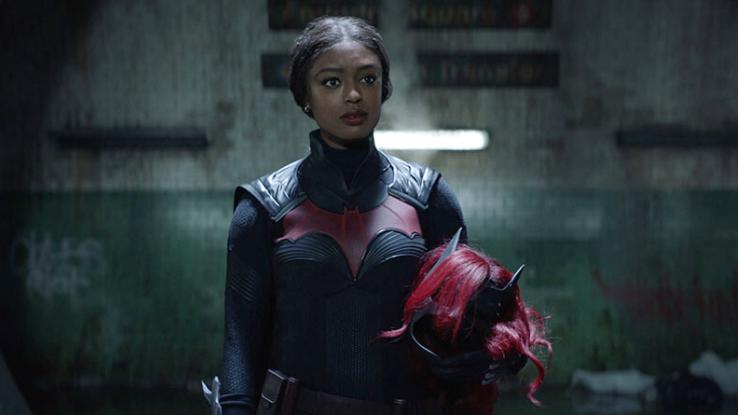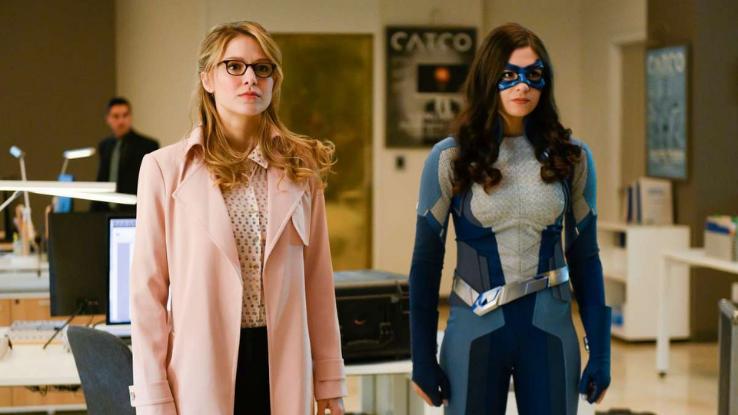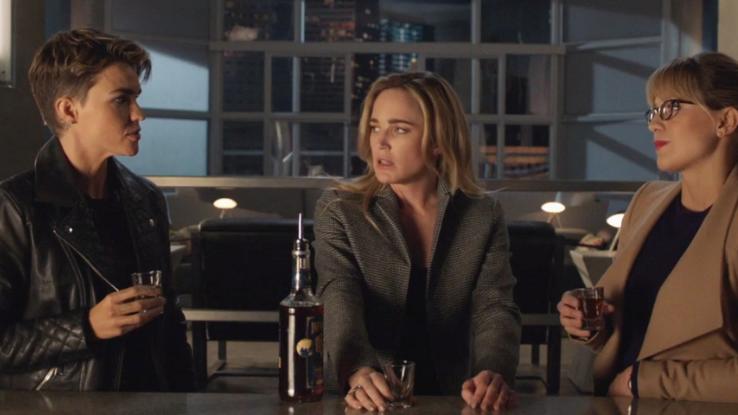Dc Comics Batman 1940 Comic Read Online

This June, DC Comics historic Pride Month on the folio with Pride-themed variant covers and the release of DC Pride, an anthology that features notable queer characters like Batwoman (a.chiliad.a. Kate Kane), Renee Montoya, Midnighter, Poison Ivy, and Harley Quinn. The drove also marks the comic volume debut of Supergirl's Nia Nal (a.k.a. Dreamer), a trans woman superhero whose DC Pride story was written by thespian Nicole Maines, who plays Nia on TV.
Of form, countless other companies are also slapping rainbow-themed imagery on their products, but DC Comics is one of few media entities moving the dial twelvemonth circular. Keeping in line with Hollywood'due south other blockbuster franchises and cinematic universes, the DC Extended Universe (DCEU) films haven't provided robust LGBTQ+ representation. Aside from Renee Montoya'south (Rosie Perez) brief run-in with an ex (Ali Wong) in Birds of Prey (2020), canonically queer characters' full identities oasis't been realized on the big screen. However, DC is making strides when it comes to representation on TV, from the animated Harley Quinn evidence to the many entries in The CW's Arrowverse.
Superhero Narratives Take Always Felt Connected to Queerness
Superhero narratives accept long been rife with metaphors about queerness: A soon-to-be-hero discovers some latent power, something new nigh themself, and learns not only to accept this new self-discovery, merely to have pride in information technology — to declare it. (Like, yous know, "I am vengeance. I am the night. I am Batman." Very declarative.) Moreover, these super-humans (or vigilantes) often hibernate their identities or keep secrets every bit a means of preserving their prophylactic and privacy.
A few superhero narratives brand the metaphor even more than apparent. Although it's not always perfect, Marvel'south long-running X-Men series is often read every bit a queer text. Unlike other large-name Marvel superheroes who are suddenly transformed into powerful beings, Ten-Men's mutants are built-in with their unique traits or powers. However, similar other heroes, X-Men's mutants struggle with (self-)acceptance and shame, only, more often than not, they must also notice rubber and acceptance inside their chosen families.

And they navigate all of this while facing threats from oppressive political systems and society at big. In many arcs, non-mutants fright the X-Men and their mutant kin. In some more dire instances, not-mutants threaten to "cure" the X-people of their innate qualities — or attempt to hunt them downward or imprison them. This strikes a stark contrast to other heroes in Marvel'due south canon — especially the magically or scientifically altered ones, similar Spider-Human or Helm America — who are historic for their traits, for saving the twenty-four hour period.
Unfortunately, the X-Men franchise hasn't really delved into this queer reading on screen. Instead, information technology has remained generally subtext, or a parallel to be gleaned from movies like Days of Future Past (2014). The exceptions? Before Disney swallowed up 20th Century Fox, movies like Deadpool 2 (2018) and The New Mutants (2020) featured queer couples onscreen: in Deadpool'due south sequel, Negasonic Teenage Warhead and Yukio were partners, and, in New Mutants, Danielle "Dani" Moonstar, a.one thousand.a. Mirage (Blu Hunt), and Rahne Sinclair, a.grand.a. Wolfsbane (Game of Thrones' Maisie Williams), nabbed even more screentime.
On the small screen, Marvel'south most notable depiction of queer characters thus far has been on the Hulu series Runaways. Based on a comic series of the aforementioned name, the prove centers on six teenagers (and ane dinosaur) from different backgrounds as they unite against a common enemy: their criminal parents, who are collectively known as Pride. Two of these teens are Nico (Lyrica Okano) — a Wiccan who wields the cabalistic Staff of 1 — and Karolina (Virginia Gardner) — a human-conflicting hybrid who learns she tin can fly and shoot beams of light from her hands. The characters' eventual first kiss marked an onscreen first for Marvel superheroes. While that moment was exciting, it too underscores simply how landmark DC's Arrowverse, with its ensemble of LGBTQ+ characters, really is — fifty-fifty now.
Batwoman is one of the newest additions to The CW'south "Arrowverse" — a robust drove of intersecting DC Comics shows that include Arrow, The Flash, Legends of Tomorrow, Supergirl, Black Lightning, Superman & Lois, and a few web series. When it beginning debuted in 2019, the bear witness starred Ruby Rose as Kate Kane, a.k.a. the titular vigilante. In this iteration, Kate is Bruce Wayne'south cousin who returns to a Batman-less Gotham and decides to don (her version of) the iconic suit.
Then, what was Kate upwards to before her stint equally the caped crime-fighter? We acquire that Kate was off finding herself afterwards she and her ex-flame Sophie Moore — who now works at Kate's father's high-terminate Gotham security house, the Crows — were kicked out of a military academy during the era of "don't enquire, don't tell." Right out of the gate, the show doesn't shy abroad from Kate's queerness, which dates back to a 2006 run of the Batwoman comics in which Kate is both Jewish and a lesbian. At the time, Out asserted that "Batwoman [was] the highest-profile gay superhero to ever grace the pages of DC Comics."
That fact, of course, fabricated casting the character all the more important. When information technology was announced that Rose, who self-identifies equally "fluid in [her] gender, but also [as] a lesbian," was chosen, fan reactions were mixed: Some felt Rose wasn't "gay enough" to don the mantle, while others pointed out that, dissimilar Kate, she isn't a Jewish person. Despite Kate'southward queerness in the comic books, others complained that the show would "brownnose" to the "social justice warrior calendar," thus turning off more than conservative viewers. Only when Batwoman premiered in the fall of 2019, it became The CW'south most-watched series premiere since Black Lightning's Jan 2018 debut.

Just the fact that Kate's open queerness didn't bear on the show's initial reception is probably not surprising to longtime Arrowverse viewers, who have become accepted to increasing LGBTQ+ representation in the DC-based shows since Arrow's 2012 debut. While there accept been quite a few landmark moments, another that stands out is the introduction of Sara Lance (Caity Lotz). Sara is perhaps better known by her White Canary moniker, or as the helm of the Waverider, a ship that allows her rag-tag team of heroes to travel through time.
The trained assassin is too canonically bisexual, a fact that's made all the more of import because she is Legends of Tomorrow'due south protagonist — not just a sidekick. Although Sara was featured on Arrow, she became a existent star when Legends debuted in 2016, paving the way for The CW's queer characters to not only captain shows and be heroes, just to feel narrative arcs that didn't just revolve around coming out, or other tropes.
Now, Arrowverse shows feature a plethora of LGBTQ+ characters: In Black Lightning, the titular hero's daughter, Anissa Pierce (Nafessa Williams), is a queer Black adult female who eventually becomes the vigilante hero Thunder (afterwards, Blackbird); John Constantine (Matt Ryan), a bisexual warlock/detective, reoccurs on Legends and in crossover storyline events; Pointer'southward Mr. Terrific is reimagined equally Curtis Holt (Echo Kellum), a happily married gay Black man; and, on Supergirl, the titular hero's sister, DEO agent Alex Danvers (Chyler Leigh), comes out as gay in the show's second season.
And, in Supergirl's fourth season, Nia Nal, a.chiliad.a. Dreamer (Nicole Maines), became the start transgender superhero on television. With Batwoman, the get-go superhero live-activity TV series to feature a queer title grapheme, The CW seems intent on exploring the intersection of queerness and superhero stories in a more than explicit way.
Batwoman Reveals Her (Queer) Identity
In a 2020 episode titled "How Queer Everything Is Today!," The CW and DC pushed the dial even farther. This mid-flavor premiere takes place after the mega-crossover upshot that saw all of the Arrowverse heroes traversing fourth dimension and space in an epic squad-upwardly. In an try to avoid spoilers, nosotros'll but say Kate Kane (Rose) found out that her cosmic destiny was to be the "Paragon of Courage" — a fancy way of saying her bravery defines her.
In the backwash of this discovery, Kate grapples with whether she's as courageous as the fates believe. The fact that she saves a police force officeholder — who publicly tries to buss her, thus causing all of Gotham to assume they're romantically involved — doesn't assistance matters. "Whenever I put on this accommodate," Kate laments, "I feel like I'yard lying to our entire urban center… I live in shadows, I wear a disguise and I let people believe that I'm dating [that police officer]. What part of that is courageous?"

Of course, divulging Batwoman'south queerness to Gotham could too inadvertently reveal she's Kate Kane. Merely, subsequently coming together a queer teen whose parents don't accept her, Batwoman decides that being a visibly queer superhero could help others struggling with their identities or acceptance. In the stop, Kate comes out publicly in a magazine interview, which is written by her super-pal Kara Danvers, a.k.a. Supergirl (Melissa Benoist).
Why is Batwoman'due south cover-story plough so important? In an article centered on bisexual hero John Constantine, The Atlantic'southward Peter Nagy writes that the "trope of heroic self-revelation is alluring because it romanticizes the thought of an authentic, clearly defined, hidden self. It is, in a way, a coming-out metaphor—ane that suggests a hero's ultimate goal should be to uncover and improve sympathize who [they] really [are]."
By having Kate stand past her truth — both in her personal life and as a superhero — the show is fully embracing that metaphor, that link between queer identity and struggle, and the struggles of these fantasy heroes. This act illuminates the connection for direct and cis viewers, but, more than importantly, it holds space for queer viewers and allows them to see even more of themselves reflected — and no longer just in the subtext.
As the first superhero live-activity Television receiver series to characteristic a gay or lesbian title character, Batwoman had a lot to shoulder. Merely, as exemplified by this episode, it's clear that showrunners have the propensity to do right by LGBTQ+ fans. In fact, this was underscored nonetheless again when Rose had to step downward from Batwoman for personal reasons subsequently the show's beginning season ended. Instead of recasting Kate Kane, the creators decided to innovate Ryan Wilder as the show'southward new pb, and cast Javicia Leslie to play the role — and wear the cape. With her casting, Leslie, a bisexual woman, has made history as the first queer Black actor to play a title character in a superhero show.
knickerbockershound.blogspot.com
Source: https://www.ask.com/entertainment/lgbtq-superheroes-feature-batwoman?utm_content=params%3Ao%3D740004%26ad%3DdirN%26qo%3DserpIndex
0 Response to "Dc Comics Batman 1940 Comic Read Online"
Post a Comment